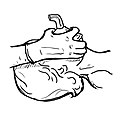Basic airway management
Basic Airway Management is a fundamental aspect of medical care, focusing on ensuring that the airway - the path through which air enters and exits the lungs - remains open and clear. This is crucial in a variety of settings, from emergency medicine to anesthesia, as it is essential for effective ventilation and oxygenation of patients. The primary goal of airway management is to prevent airway obstruction, which can lead to hypoxia and potentially life-threatening conditions.
Overview[edit]
The airway can be divided into the upper and lower airway. The upper airway consists of the nasal and oral cavities, pharynx, and larynx. The lower airway includes the trachea, bronchi, and lungs. Basic airway management techniques are primarily concerned with the upper airway, as this is most susceptible to obstruction.
Indications[edit]
Airway management is indicated in any situation where there is a risk of airway compromise. This can include, but is not limited to, patients who are unconscious, have suffered trauma, are experiencing anaphylaxis, or have acute medical conditions such as asthma exacerbations or heart failure.
Techniques[edit]
Several techniques are employed in basic airway management to ensure the airway remains open and functional:
Head Tilt-Chin Lift[edit]
The head tilt-chin lift maneuver is used in patients who are unconscious but without suspicion of a cervical spine injury. It involves tilting the patient's head back and lifting the chin to open the airway.
Jaw Thrust[edit]
The jaw thrust maneuver is an alternative to the head tilt-chin lift, especially in patients where cervical spine injury is suspected. It involves lifting the jaw forward without moving the neck to open the airway.
Airway Adjuncts[edit]
Airway adjuncts, such as the oropharyngeal airway (OPA) and nasopharyngeal airway (NPA), can be used to maintain an open airway. These devices are inserted into the mouth or nose, respectively, to prevent the tongue from blocking the airway.
Suctioning[edit]
Suctioning is used to clear the airway of secretions, blood, vomit, or other debris. This is critical in preventing aspiration and maintaining a clear path for air.
Assessment and Monitoring[edit]
Continuous assessment and monitoring of the airway are vital components of airway management. This includes observing for signs of effective ventilation and oxygenation, such as normal skin color, chest rise, and the absence of abnormal sounds like stridor or wheezing.
Complications[edit]
Complications of airway management can include trauma to the airway, aspiration of stomach contents, and hypoxia if the airway is not effectively managed. Proper technique and vigilance are essential to minimize these risks.
Training and Education[edit]
Healthcare providers, including paramedics, nurses, and physicians, receive training in basic airway management techniques. This training is often part of basic life support (BLS) and advanced life support (ALS) courses.
Conclusion[edit]
Basic airway management is a critical skill in healthcare, providing the foundation for advanced interventions and ensuring patient safety through effective ventilation and oxygenation. Continuous education and practice are essential for healthcare providers to maintain proficiency in these lifesaving techniques.
-
Basic airway management
-
Basic airway management
-
Basic airway management
-
Basic airway management
-
Basic airway management
-
Basic airway management
-
Basic airway management
-
Basic airway management
-
Basic airway management
-
Basic airway management
Ad. Transform your life with W8MD's Budget GLP-1 injections from $75


W8MD offers a medical weight loss program to lose weight in Philadelphia. Our physician-supervised medical weight loss provides:
- Weight loss injections in NYC (generic and brand names):
- Zepbound / Mounjaro, Wegovy / Ozempic, Saxenda
- Most insurances accepted or discounted self-pay rates. We will obtain insurance prior authorizations if needed.
- Generic GLP1 weight loss injections from $75 for the starting dose.
- Also offer prescription weight loss medications including Phentermine, Qsymia, Diethylpropion, Contrave etc.
NYC weight loss doctor appointmentsNYC weight loss doctor appointments
Start your NYC weight loss journey today at our NYC medical weight loss and Philadelphia medical weight loss clinics.
- Call 718-946-5500 to lose weight in NYC or for medical weight loss in Philadelphia 215-676-2334.
- Tags:NYC medical weight loss, Philadelphia lose weight Zepbound NYC, Budget GLP1 weight loss injections, Wegovy Philadelphia, Wegovy NYC, Philadelphia medical weight loss, Brookly weight loss and Wegovy NYC
|
WikiMD's Wellness Encyclopedia |
| Let Food Be Thy Medicine Medicine Thy Food - Hippocrates |
Medical Disclaimer: WikiMD is not a substitute for professional medical advice. The information on WikiMD is provided as an information resource only, may be incorrect, outdated or misleading, and is not to be used or relied on for any diagnostic or treatment purposes. Please consult your health care provider before making any healthcare decisions or for guidance about a specific medical condition. WikiMD expressly disclaims responsibility, and shall have no liability, for any damages, loss, injury, or liability whatsoever suffered as a result of your reliance on the information contained in this site. By visiting this site you agree to the foregoing terms and conditions, which may from time to time be changed or supplemented by WikiMD. If you do not agree to the foregoing terms and conditions, you should not enter or use this site. See full disclaimer.
Credits:Most images are courtesy of Wikimedia commons, and templates, categories Wikipedia, licensed under CC BY SA or similar.
Translate this page: - East Asian
中文,
日本,
한국어,
South Asian
हिन्दी,
தமிழ்,
తెలుగు,
Urdu,
ಕನ್ನಡ,
Southeast Asian
Indonesian,
Vietnamese,
Thai,
မြန်မာဘာသာ,
বাংলা
European
español,
Deutsch,
français,
Greek,
português do Brasil,
polski,
română,
русский,
Nederlands,
norsk,
svenska,
suomi,
Italian
Middle Eastern & African
عربى,
Turkish,
Persian,
Hebrew,
Afrikaans,
isiZulu,
Kiswahili,
Other
Bulgarian,
Hungarian,
Czech,
Swedish,
മലയാളം,
मराठी,
ਪੰਜਾਬੀ,
ગુજરાતી,
Portuguese,
Ukrainian









